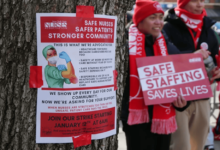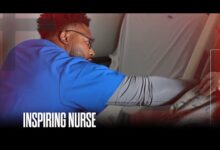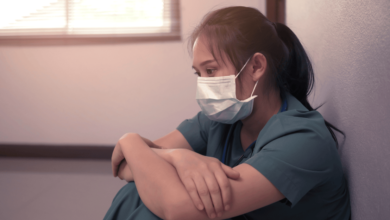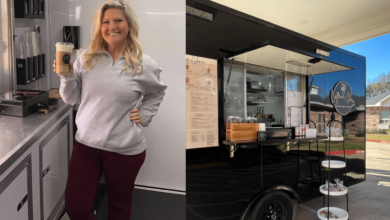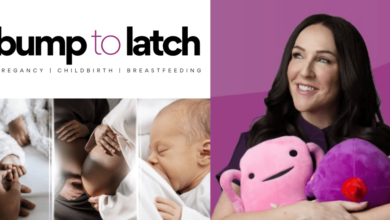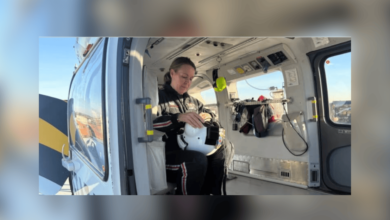Covid inquiry: former England CNO reflects on ‘tough decisions’
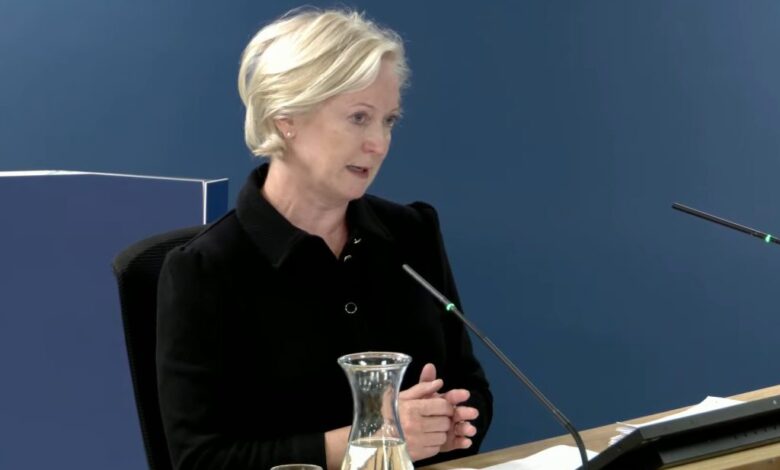
Former chief nursing officer (CNO) for England Dame Ruth May has said “difficult decisions” she had to make in the early stages of the pandemic will stay with her forever.
She also said that the removal of the nursing bursary was a “catastrophic” mistake and meant England’s NHS went into the pandemic with severe workforce shortages.
“There were occasions when there was one critical care nurse for six patients… this decision will stay with me forever”
Ruth May
Dame Ruth made the comments today as part of an evidence session for Module 3 of the UK Covid-19 Inquiry, which began last week.
This module focuses on the impact of the pandemic on UK health systems, the health workforce and the patients cared for by it.
The former CNO for England was questioned by lead counsel to the inquiry Jacqueline Carey KC on her role in the preparation and response to the pandemic, key decisions she made which impacted nursing and midwifery – and her experiences working on the front line at times.
Dame Ruth spoke about the enormous workforce capacity issues in the NHS before the pandemic, something mentioned at a previous inquiry session by former Unison head of health Sara Gorton.
There were, Dame Ruth told the inquiry, 40,000 nursing vacancies and a 20-30% staff absence rate across all sections of the health service before the pandemic hit in early 2020.
She said the difficulties the NHS was having even before the pandemic hit were in part due to the removal of the nursing tuition fee bursary some years prior by former chancellor George Osborne.
“It meant there was a significant drop, indeed a 23% drop in nursing and midwifery [university] applications as a result of that,” said Dame Ruth.
“So instead of nurses being trained, like I was and like many other nurses were, we received free education and a maintenance grant. Nurses and midwives… ended up with a lot of debt.”
Dame Ruth continued: “It meant that we were 5,000 fewer nurses in March 2020 because of that decision, and 700 fewer midwives.”
Ms Carey asked the former CNO to discuss the impact of this on the workforce when Covid-19 hit.
“Per hospital, it would be about 40 extra nurses… I think it would have made a difference.
“Maybe we needn’t have made some of the decisions around critical care ratios. Of course, if we had more nurses, there’d be less burnout, less psychological impact.
“Removing the bursary, for me, was a catastrophic decision.”
During the pandemic, a 1:1 rule for ratios of critical care nurses to patients was relaxed, meaning that at times some settings had a ratio of as much as 1:6.
The inquiry heard how Dame Ruth led the decision, which was formally made by the NHS England National Incident Response Board (NIRB), to change the rule on 22 March 2020.
Dame Ruth recalled being told that there were 4,000 critical care beds in England, but that within 16 days the capacity would need to be at around 7,000.
“Removing the bursary, for me, was a catastrophic decision”
Ruth May
The inquiry heard how she sought advice from the British Association of Critical Care Nurses and other experts, and that the conclusion was that a “team approach” could be taken in which the ratio for critical care nurses was diluted with nurses and other professionals outside of the specialty.
Dame Ruth said: “Critical care [demand] was doubling, tripling, quadrupling – 10 times the capacity in places. We were seeing reports in Italy where patients weren’t able to go into hospital.”
“Not ideal at all,” Dame Ruth said of the changing of staffing ratios. “And I know that there has been consequences because of it.”
The former CNO spoke movingly about this decision, which she said was “not where we wanted to go”, acknowledging that it had an impact on nurses, and inevitably, on patients in intensive care.
Dame Ruth added: “There were occasions when there was one critical care nurse for six patients. There were other professionals – but this decision will stay with me forever.”
Like other senior nursing leaders during the pandemic, Dame Ruth worked shifts at her local hospital to help meet the need for raised capacity.
She recalled, visibly upset as she did, the working conditions on these shifts, which included spells working in the Nightingale Hospitals and, in some instances, intensive care: “It was such a privilege… it really was a privilege to be a nurse.
“I actually nursed a nurse, which was a privilege… I had the great privilege in December [2020]-January [2021] to work in the vaccine programme. That gave me hope.
“I also worked in ITU on a Sunday morning… There was death. There were deaths, there weren’t visitors, nursing ratios were stretched – but it was very powerful because I was able to go back then to Matt Hancock, and go, ‘This is what my recommendation is, no we’re not doing that, yes we are doing that.’”
Dame Ruth recalled wearing full-body personal protective equipment (PPE) and the physical stress this put on her and her nursing colleagues’ bodies, such as the “indents” left on their cheeks from masks.
After one critical care shift in January 2021, the inquiry heard, Dame Ruth met with then-health secretary Matt Hancock who asked if diluted staff ratios could be maintained.
Dame Ruth told the inquiry: “He said, why can’t we do 1:3 [critical care nurses to patients] all the time? I said, ‘No, I was there yesterday morning’. I explained to him what it was like.
“He backed me, and we did a maximum of 1:2 during the next wave [of Covid-19].”
Dame Ruth was also asked about other measures, such as the deployment of student nurses in their final six months of study into the workforce to support substantive nurses, which she felt forced to take out of necessity.
“None of us wanted to do this,” said Dame Ruth. “We wanted to continue their education, but we were in such a position that we needed to increase workforce numbers.
“So we debated it… it was a choice which people were able to make, and people did make the choice not to go onto the frontline and we respected that.”
She added: “This was not an easy decision, but student nurses were amazing support… it was difficult, but they were amazing.”
The additional impact of the pandemic on minority ethnic staff was raised during Dame Ruth’s evidence session, as it has been several other the evidence sessions for Module 3 so far.
Asked what she felt the key challenges were, Dame Ruth said: “It was tougher for them than people from my background.
“At the Nightingale [Hospital], there were 30 patients [at one stage], and all but one were from a [minority ethnic] background and this was replicated in critical care units.
“So then if you were [minority ethnic staff] treating patients who also looked like you, that was tough for them – very tough.
“And so that’s why we did a lot of work to support [international nursing and midwifery associations] like the Filipino Nurses Association and the British Indian Nurses Association.”
Dame Ruth explained that, as a result, risk assessments were introduced for all minority ethnic staff to account for this additional impact, and that she had pushed for the roll out of these to be sped up.
Ms Carey questioned Dame Ruth on a variety of issues relating to nursing strategy, policy and practice during the pandemic. A summary of the key points raised can be found on Nursing Times’ live coverage of the evidence session.
One of these topics was Dame Ruth’s role in the development of infection protection and control (IPC) guidance for the healthcare workforce.
The former CNO was the senior responsible officer for England in the UK IPC Cell during the pandemic, which involved discussing and challenging PPE guidance.
She noted how she had first become aware of PPE supply issues in March 2020 and that she had worked with then-Royal College of Nursing chief executive Dame Donna Kinnair to tackle issues around gowns.
“It was a very stressful time,” she said. “It was Easter weekend, Donna and I spoke more times than we spoke to our families.
“We were completely aligned that we needed to concentrate on getting more gowns and not moving to aprons, because that wouldn’t protect nurses in the way we felt they needed to be protected.”
Dame Ruth, at the end of the session, was asked for her key recommendations to the inquiry to better prepare the health service for a future pandemic.
She agreed that visiting guidance for maternity care, and those who require carers, could be clearer in future.
Further, she said that the country must ensure it had the “workforce supply” needed to weather a health crisis. To this end, she reiterated her call for the restoration of the nursing tuition bursary.
“The domestic supply of nurses and midwives is key to a future pandemic,” said Dame Ruth, who also highlighted the value of early testing to monitor the spread of a disease.
More from the Covid inquiry

